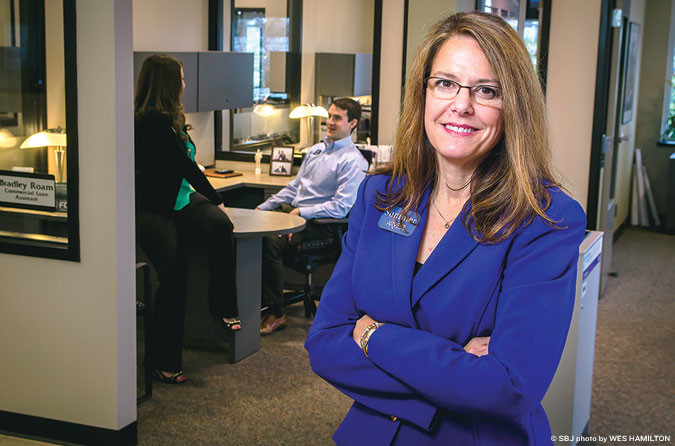YOUR BUSINESS AUTHORITY
Springfield, MO
YOUR BUSINESS AUTHORITY
Springfield, MO

In September 2008, the lending world essentially closed its doors. The federal government took over giants Fannie Mae and Freddie Mac, the subprime mortgage crisis hit rock bottom and the nation was in a great recession.
Seven years later, banks have clawed their way back to some semblance of a new normal, filled with increased regulations and tighter net interest margins. The players have shrunk due to fewer bank startups and more consolidations, but local bankers say the lending doors are open once again.
“The lending environment is competitive and strong right now,” said John Everett, president and CEO of Legacy Bank and Trust. “There is a lot of demand, but loans vary depending on the segment. Banks are still hesitant to lend on startups but eager to secure commercial loans.”
According to the Federal Reserve Board’s third-quarter senior loan officer opinion survey on bank lending practices, banks reported having eased some loan terms, such as spreads and loan maturities. However, banks also indicated they increased premiums charged on riskier loans at larger firms.
According to the responses from 69 domestic banks and 23 U.S. branches and agencies of foreign banks, commercial and industrial loans experienced stronger demand during the third quarter.
Across the Show-Me State, the Missouri Division of Finance reports loans at the state’s 262 banks and trust companies totaled $67.5 billion as of June 30, an 11.4 percent increase compared to a year earlier. Through Sept. 30, Legacy’s loan totals increased 15.4 percent to $120 million compared to 2014. Reaching what Everett calls historically high, typical growth numbers are around 4 percent annually.
Assets at state-chartered banks grew 6.5 percent to nearly $107 billion though the second quarter, and deposits are up 5.9 percent to $88.6 billion.
“The overall condition … continues to improve,” said Christine Kineannon, acting deputy commissioner, in a news release. “Asset quality has improved since last year, with the past due ratio declining to a manageable 1.33 percent from 1.77 a year earlier.”
Becoming teachers
While the current lending atmosphere is trending up, it hasn’t been without considerable effort and change for local bankers.
“We’ve all heard Jack Stack famously say he went to the bank and didn’t know a thing about getting a loan,” said Summer Massey, senior vice president and commercial loan manager for Arvest Bank.
“That seems to be more and more the reality these days. We are five solid years into recovery, and there are a lot of folks who don’t understand how underwriting a loan works.”
To combat the growing problem, Massey said Arvest has focused its efforts on financial literacy, helping people, such as small-business owners, determine where they’d like to end and helping define that path.
“It’s really a response to the market; it’s what business customers were missing,” she said. “Customers are frustrated they can’t get loans. That’s understandable from a banker’s point of view if they don’t understand the process. We translated that frustration into a solution for the community.”
Everett said online resources have helped Legacy Bank customers enter the bank more informed, but there still is a learning curve.
“Sometimes, people just don’t know where to start,” he said. “That’s where the education comes in.”
Lingering fears
Then there’s the competitive side of the lending environment.
Joe James, executive vice president and senior lending officer with First Home Bank, said the southwest Missouri lending environment is extremely competitive, leading to a chase for dollars.
“Everyone is chasing those high-quality loans. It could be a quick death for a bank with nonquality assets in this environment,” he said. “That chase makes a lot of people get crazy on rates. That’s part of what got us into trouble in the first place.”
When James joined First Home three years ago, loan volumes were roughly $93 million. That’s up to $123 million now, growing roughly 7 percent since the start of the year.
However, a recent Springfield Business Journal report found government-backed loans, such as Small Business Administration-backed loans, are down. The Springfield metropolitan statistical area generated 175 SBA loans worth $49.08 million in fiscal 2015, which ran through Sept. 30. That’s down nearly 10 percent from 192 loans in fiscal 2014 worth $59.96 million.
“We often start with SBA loans, but a lot of people don’t even want to go there because they don’t want to deal with the government,” Everett said. “There is a lack of and a general distrust in the federal government, when in reality, it’s usually their best choice.”
With many banks teetering on the precipice of financial failure, Congress passed new regulations designed to stymie loose lending practices and sheer up the crumbling financial pillars. However, lenders soon learned the new regulations made operating a bank more cumbersome and expensive. James and Everett agree lenders are settling into a new normal.
“Banks have a lot of money they want to lend,” James said. “But the memories of past scars create a hesitation.”
Alair Springfield is first Missouri franchise for Canada-based company.